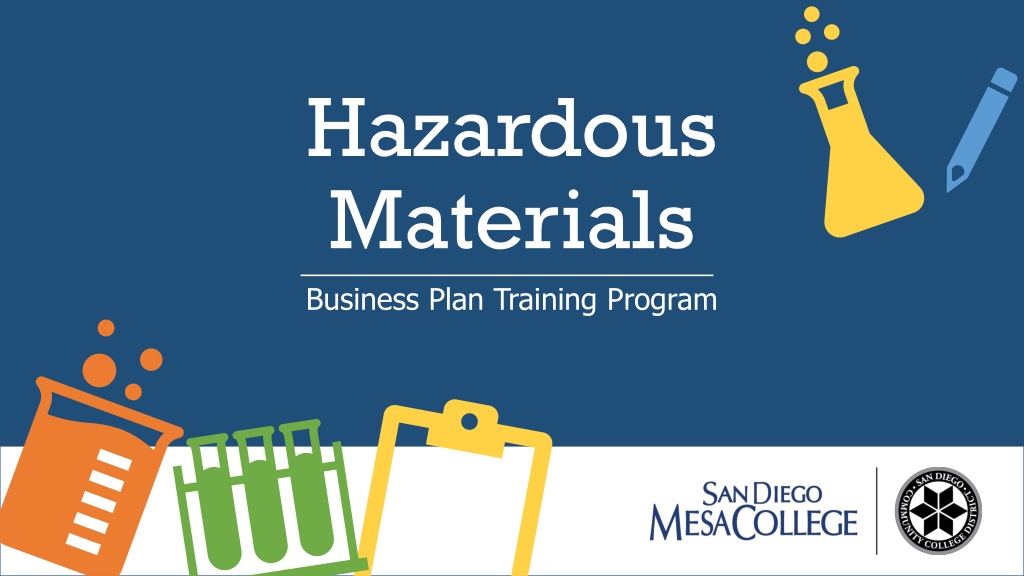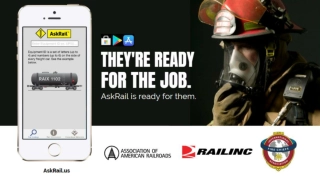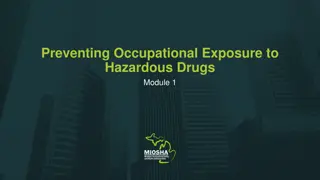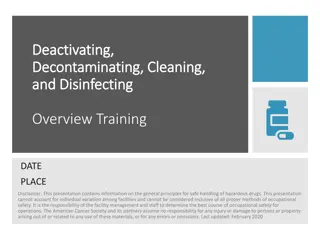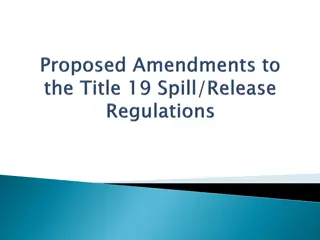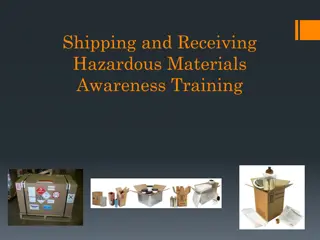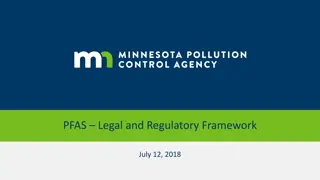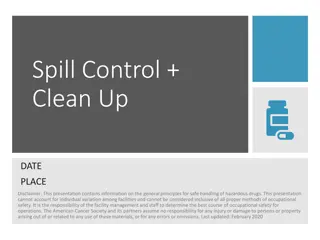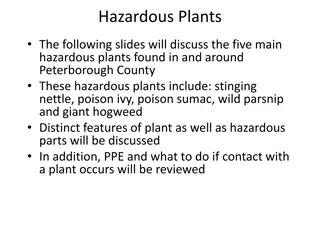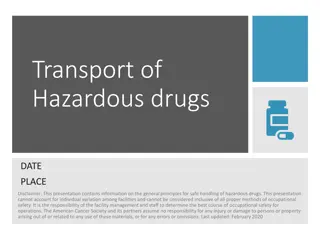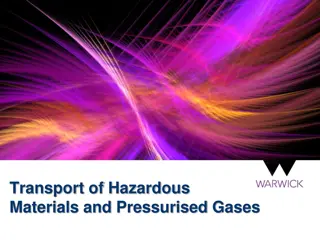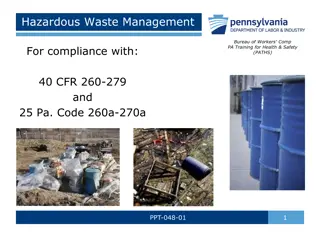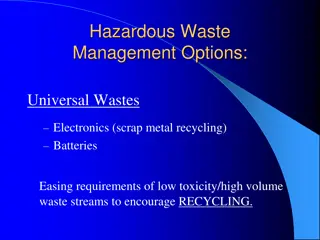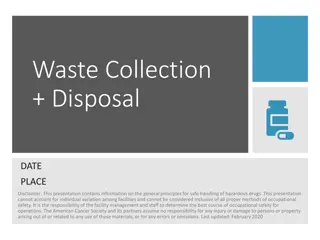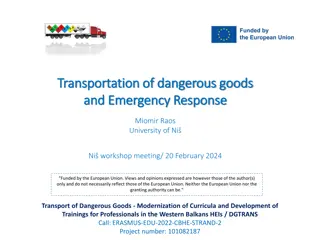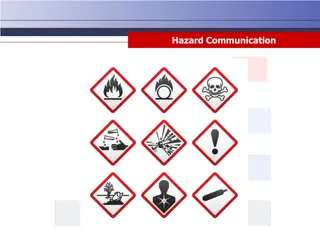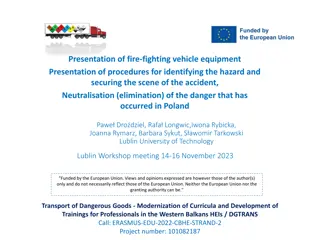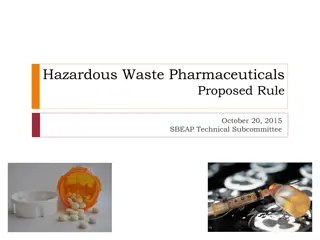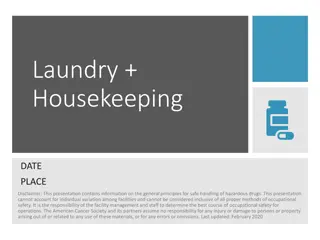Hazardous Materials Business Plan Training Program
Facilities subject to the Hazardous Materials Business Plan (HMBP) Program must implement a training program for employees on hazardous materials safety and emergency response. This includes initial training for new employees within 30 days of hire and annual refresher training. Training covers safe handling of hazardous materials/waste, emergency response equipment, procedures, and mitigation strategies such as engineering and administrative controls. San Diego Mesa College utilizes administrative controls alongside engineering controls, with standard operating procedures (SOPs) outlined in the Chemical Hygiene Plan (CHP) for chemical handling, storage, and waste management.
Download Presentation

Please find below an Image/Link to download the presentation.
The content on the website is provided AS IS for your information and personal use only. It may not be sold, licensed, or shared on other websites without obtaining consent from the author.If you encounter any issues during the download, it is possible that the publisher has removed the file from their server.
You are allowed to download the files provided on this website for personal or commercial use, subject to the condition that they are used lawfully. All files are the property of their respective owners.
The content on the website is provided AS IS for your information and personal use only. It may not be sold, licensed, or shared on other websites without obtaining consent from the author.
E N D
Presentation Transcript
Hazardous Materials Business Plan Training Program
Introduction All facilities subject to the Hazardous Materials Business Plan (HMBP) Program must have a training program and a written employee training plan for hazardous materials safety and emergency response. Initial training is required for new employees within 30 days from date of hire followed by annual refresher training. Training to include: Procedures for safe handling of hazardous materials/waste Use of emergency response equipment and materials Emergency response procedures
Procedures for safe handling of hazardous materials/waste The control of the exposure, release, and spread of hazardous materials and waste is accomplished by the integration of mitigation strategies, including: Personal Protective Equipment Engineering Controls Administrative Controls
Engineering Controls These controls focus on the source of the hazard, unlike other types of controls that generally focus on the employee exposed to the hazard. Engineering controls should be the first application of safety measures used when evaluating hazard mitigation. Engineering controls are based on the following broad principles: Design work areas or process to remove hazard and/or substitute something that is not/less hazardous. If removal is not feasible, enclose hazard to prevent exposure in normal operations. Where complete enclosure is not feasible, establish barriers or local ventilation to reduce exposure in normal operations
Administrative Controls Administrative controls are policies and procedures designed to reduce employee and student exposure to hazardous chemicals. The use of standard operating procedures (SOP s), general laboratory guidelines, housekeeping, and chemical handling procedures are administrative controls used by San Diego Mesa College. Administrative controls should be the second application of safety measures used when evaluating hazard mitigation and are used in conjunction with engineering controls.
Mesa College Standard Operating Procedures (SOPs) The Mesa College Chemical Hygiene Plan (CHP), combined with training, will act as the Standard Operating Procedures for those processes that involve chemical movement, storage, and chemical/waste handling. Individual Departments may write supplemental Standard Operating Procedures to delineate site-specific program compliance for their unique programs and hazards, but they must be at least as stringent with the contents of the CHP. General Chemical Safety Guidelines Housekeeping Chemical Handling Chemical Storage Transporting Chemicals and Chemical Waste Compressed Gas Cylinders
General Chemical Safety Guidelines Personnel should not work with or transfer flammable or toxic hazardous materials alone. Employees should wash hands with soap and water prior to leaving the area where hazardous materials are used. All work with volatile chemicals shall be conducted in the fume hoods or other well-ventilated areas. Areas where hazardous materials or waste are stored shall be secured from unauthorized access.
Housekeeping All doorways, walkways and staircases are to remain clear and free from obstructions, chemicals, or hazardous waste. The area around eyewashes and safety showers shall always remain clear of obstructions to a distance of at least twenty- four (24) inches. Areas shall be kept clean and neat. Small drips or spills of chemicals shall be wiped up immediately using appropriate PPE and proper materials for the chemical. Materials used for cleaning spills shall be disposed of as hazardous waste.
Chemical Handling Chemical handling is the application of best practices to minimize the risk in using, moving, or transferring chemicals. The basis of safe chemical handling is being aware of what chemicals are present in the workplace and their associated hazards.
Chemical Inventory The Hazardous Communication Standard requires a current chemical inventory in areas that use or store hazardous materials. Each department will update its Chemical inventory, have a hard copy available in the area the chemicals are stored, and submit a copy to the OEHS Coordinator no later than January 31 of each calendar year. Mesa College s chemical inventory format has been standardized and each department must use the standardized format when creating a chemical inventory. If there are any questions or concerns about the format or process, contact the campus OEHS Coordinator. Every hazardous chemical that is used on the Mesa campus must have a corresponding SDS.
Receiving Chemicals No outside donations of chemicals, either new or partially consumed can be excepted All chemicals shall have the date received, person receiving, and the date they were opened written on the label. As applicable, expiration dates shall be written on the container label.
Chemical Labeling Chemicals should be kept and stored in the container supplied by the manufacturer. In the event a chemical must be repackaged due to damage, the new container shall be compatible with the material and the label shall include all of the required elements. Every original container label must include: Product Identifier Signal Word Hazard Statement(s) Pictogram(s) Precautionary Statement(s) Name, address, and telephone number of the manufacturer or importer Label must be legible, permanently displayed, and written in English
Chemical Labeling Secondary Containers: Secondary containers are containers used to supply smaller amounts of chemicals from bulk containers to more than one location, such as instructional laboratories or custodial closets. Secondary containers must be of similar material and quality to the original. Secondary containers must be labeled with The name of the chemical or common name, in English. The concentration of the chemical shall also be noted, if appropriate. Pictogram(s) and/or other applicable hazard warnings. Date chemical was transferred into container.
Chemical Storage All storage locations for hazardous materials or hazardous wastes shall be labeled with warning signs in accordance with NFPA 704 on each door or entrance. Chemicals shall be stored in the appropriate storage location, separated and segregated from incompatible chemicals. Chemicals shall not be stored at elevations more than six (6) feet from the floor. Shelves holding chemicals shall have lips or other integral restraining devices to prevent chemicals from sliding off (24 CCR, Part 9, 5003.9.9). Cabinets specially designed for hazardous chemicals do not require lips. Chemical storage cabinets or refrigerator/freezer must have the appropriate labeling such as: Flammable, Corrosive, Acid, Base, Poison, Compressed Gas, or any other appropriate identifier
Transporting Chemicals and Chemical Waste Chemical and waste containers shall be securely capped prior to transport. A secondary container, such as a poly bucket or tub, must be used when transporting chemicals. Containers carrying more than 4 liters/1 gallon are to be transported by a cart, dolly, or other means. Hazardous chemicals and waste should not be moved via stairwells. Hazardous chemicals and waste shall be moved between floors by way of elevators. o Hazardous chemicals and waste that are moved via elevator shall have a means of secondary containment. o The maximum size container allowed to be moved in an elevator is twenty (20) liters (5.28 gallons) (24 CCR, Part 9, 5003.10.4.2). Incompatible chemicals shall not be transported on the same cart or truck (24CCR, Part 9, 5003.10.3.6.).
Compressed Gas Cylinders - Storage Areas containing compressed gas shall be marked Compressed Gas and be secured to prevent access by unauthorized individuals. When not in use, including when empty, cylinder valves shall be fully closed with protective caps securely in place. Cylinders shall not be stored under stairs or near emergency exits. Cylinders shall be stored upright in secured racks, or secured to a fixed object by no fewer than two restraints. Cylinders shall not be stored in direct sunlight or near other sources of heating to prevent over-pressure hazards. Empty cylinders shall be clearly marked Empty and stored separately from full or in-use cylinders.
Compressed Gas Cylinders -Moving and Labeling When moving cylinders: Use cylinder carts and secure while moving. Do not roll on their edges. Must be capped. Remove regulators. Labeling: Cylinder shall be clearly labeled as to its contents. Cylinders shall be labeled Full, In Use, or Empty as appropriate.
Compressed Gas Cylinders - Cylinder Failure If a cylinder or valve assembly begins to leak or the valve cannot be closed: For non-toxic, non-flammable, and non-corrosive gases, the cylinder shall be moved to an exterior location away from buildings or pedestrian walkways and allowed to vent. If the gas could be an asphyxiate, leave where it is at and evacuate immediate surroundings and push the red button to contact emergency dispatch or call campus police dispatch For toxic, flammable, and corrosive gases, the incident shall be treated as an uncontrolled release- details for response can be found in the CHP under Emergency Response Procedures, or refer to the EAP Guide.
Personal Protective Equipment (PPE) When exposure to hazards cannot be engineered completely out of normal operations or maintenance work, and when safe work practices and administrative controls cannot provide sufficient additional protection from exposure, personal protective equipment may be required. PPE is the last line of defense against chemical hazards since any failure in the measure will likely result in an exposure. Please work with your supervisor to ensure proper PPE including: General Guidelines & Minimum Standards Gloves Laboratory Coats Shoes Eye Protection
PPE General Guidelines and Minimum Standards Shorts, pants that expose any skin, and skirts or dresses that come above the ankle may not be worn in laboratory areas were chemicals are present. The area of skin between the pants and the shoe should not be exposed. Tank tops, sleeveless shirts, or shirts that expose the chest shall not be worn when working with chemicals unless covered by a laboratory coat or other protective apparel.
PPE Gloves Gloves are required to be worn by any employee who opens, handles, transfers, pours, or otherwise uses hazardous chemicals of any amount, including toxic, corrosive, and refrigerant gases. Each Department is responsible for providing employees with gloves. Gloves should be inspected for defects prior to donning, if a defect is found, the glove is to be discarded and replaced.
PPE Laboratory Coats Laboratory coats shall be at least knee length. Lab coats shall be worn by employees whenever they are working with hazardous chemicals or hazardous waste. Laboratory coats shall be inspected prior to each use for defects. Damaged or defective laboratory coats shall not be worn. When working with chemicals, laboratory coats shall be worn with the sleeves long enough to protect exposed skin and under clothing. Lab coats should be properly buttoned. Laboratory coats shall not be worn outside the laboratory or areas where chemicals are not present unless chemicals are being transported. Laboratory coats shall be laundered on a regular basis. Chemical resistant aprons should be worn over laboratory coats for specific tasks that have a high probability for splashing.
PPE Shoes & Eye Protection All employees, students, and visitors shall wear close-toed and close-heeled shoes that cover their entire foot whenever they are handling or transferring chemicals or waste. o Flip flops, clogs, or other sandal-type shoes shall not be worn when working with chemicals. Chemical safety splash-resistant goggles shall be worn at all times by faculty, employees, and students when hazardous chemicals are being used or when handling hazardous waste and there is a possible risk of a chemical splash.
PPE Eye Protection All goggles shall be ANSI Z87.1 certified and be clear, not tinted. Safety glasses can be worn by employees in lieu of splash goggles when no splash hazards exist (However, splash goggles are highly recommended as they will provide greater protection from chemical exposure). For example: An individual is walking through a chemical use area, but is not using or directly standing next to someone using hazardous chemicals. Working with solid materials (and not making solutions) Conducting flame tests. Using impregnated chemicals. Using small dropping bottles (30ml or less) and dispensing the chemical with a dropper. Doing animal dissections.
Hazardous Chemical Waste San Diego Mesa College generates both liquid and solid hazardous waste. The waste must be removed from the site before the 90th day from the listed start date on the individual container. The waste is then transported by a hazardous waste contractor for treatment or disposal at an appropriately licensed facility. This will require knowledge of: Chemical Waste Special Waste Classes Chemical Waste Containers Chemical Waste Storage Facilities Hazardous Waste Profiles Hazardous Waste Manifest
Hazardous Chemical Waste The waste in the storage area shall be segregated and separated by hazard class and placed into containers that are no larger than 5 Gallons. Waste shall be separated into at least the following hazard classes in separate containers: o Ignitable (22 CCR 66261.21) o Corrosive (22 CCR 66261.22) o Reactive (22 CCR 66261.23) o Toxic (22 CCR 66261.24) o Other waste categories may be designated by the Departments as appropriate.
Hazardous Chemical Waste Separate containers shall be used for solid waste, each liquid waste category, and containerized waste for each hazard class (22 CCR 66262). Waste of similar hazard classification may be consolidated into larger containers. o Consolidation refers to the practice of emptying smaller containers into a larger container to combine liquid or solid wastes into a single container.. Only compatible wastes can be placed in the same container. Waste from different departments shall not be consolidated.
Special Waste Classes There are specific classes or types of hazardous waste that have additional labeling, packaging, handling, or storage requirements. See Appendix A in the CHP for additional details Liquid paint. Dry paint Used oil Used oil filters Empty chemical or hazardous waste containers Aerosol cans Pesticides
Chemical Waste Containers The following requirements apply to all waste containers: Containers shall be compatible with the material they are designated to contain (22 CCR 66265.172). o Containers that are to be disposed of with the waste ( lab packed ) must be (49 CFR 173.12(b)(2)(i)): One (1) gallon or smaller for glass containers Less than 5.3 gallons for plastic (20 L) Have secure, tight-fitting lids, preferably threaded, that do not react or degrade with the waste class within. Containers shall prevent the leakage of liquid, solid materials, or vapors.
Chemical Waste Containers All containers shall have appropriate lids that close securely. o Lids are to remain in place unless waste is actively being added or removed from the container. Funnels can be used to facilitate adding waste to the containers. o Funnels shall either have self-closing lids or be removed when waste is not being added. Container must be closed when funnel is removed.
Chemical Waste Containers: Labeling Containers shall be clearly, visibly, and legibly labeled Hazardous Waste. Unused portions of chemicals can be disposed of in their original containers as long as the container is properly labeled as hazardous waste. Labels shall be durably affixed to the container. The following information shall be clearly and legibly entered on the label in blue/black ink: o List of chemical(s) being placed in container. o EPA ID number San Diego Mesa College HAS only one (1) unique EPA identification number, obtained by the State, to be used for tracking all generated waste. o Street address of Mesa College: 7250 Mesa College Dr., San Diego, CA. 92111 o Contact phone number from the area/Department generating the waste. o Hazard class of waste. o Physical form of waste o Date the first waste was placed into the container
Chemical Waste Storage Facilities (8 CCR 5534, 22 CCR 66261, 22 CCR 66262, 40 CFR 262.34) Point of Generation Accumulation Areas Accumulation areas shall: Be locked to prevent unauthorized access. Be labeled on the exterior as containing hazardous waste. Be marked with an NFPA 704 hazard warning label. Have adequate ventilation Have adequate and appropriate storage for hazardous waste containers. Have containers placed in or on a means of secondary containment in the event of spills or leaks.
Chemical Waste Storage Facilities (8 CCR 5534, 22 CCR 66261, 22 CCR 66262, 40 CFR 262.34) Waste of similar hazard classification may be consolidated only if the exact composition is known and compatibility has been assessed by a competent person. In this instance, a competent person is a person with knowledge of the chemical and physical properties of all substances to be combined as well as any potential reactions Chemicals with the following properties will not be consolidated or combined with any other chemicals: o Pyrophoric o Water reactive o Organic peroxides o Self-reactive o Flammable solids.
Chemical Waste Storage Facilities (8 CCR 5534, 22 CCR 66261, 22 CCR 66262, 40 CFR 262.34) Wastes shall not be treated, neutralized, or intentionally mixed in an attempt to render the waste less- or non-hazardous. Waste containers shall be removed from the classrooms when the containers are approximately full. Instructional laboratories that contain waste shall be locked or otherwise have access restricted when class is not in session; otherwise, the waste containers shall be removed.
Hazardous Waste Profiles Hazardous waste profiles are records that delineate the content and associated hazard characteristics of a particular waste stream. Each Department, that generates hazardous waste, can create and will maintain their departments waste profiles with the contracted hauler. Hazardous waste profiles must accurately reflect the waste in any particular container. Profiles may be reviewed by the hazardous waste contractor. Profiles must be updated annually or whenever there is a change before the waste can be removed from the College.
Hazardous Waste Manifest A manifest is a tracking document that is used to identify the owner of hazardous wastes throughout the generation, transportation and disposal process (49 CFR 172.204). For Mesa College the Hazardous Waste Manifest is filled out by the waste hauler Clean Harbors. The Manifest should be signed by a San Diego Mesa College representative, preferably the appointed department hazardous waste lead, or by the OEHS Coordinator or the Campus Chemical Hygiene Officer o The campus representative must receive US Department of Transportation or Title 22 training before they can sign a manifest (49 CFR 172.704). Refresher training must be completed every three (3) years. The campus representative will receive a copy of the manifest by the hauler.
Hazardous Waste Manifest oA copy of this manifest must be sent, by the appointed department hazardous waste lead, within thirty (30) days of shipment to: Department of Toxic Substances Control, P.O. Box 400, Sacramento, CA 95812-0400. An additional copy must be forwarded to the Campus OEHS Coordinator. o A final copy will be sent or available to San Diego Mesa College upon receipt at the final waste handling destination. o The manifests signed by the TSDF must be kept for three (3) years. The Campus OEHS Coordinator or their designee is responsible for retaining all copies of the final manifests.
Universal Waste Universal wastes (UW) are hazardous wastes of specific categories that are exempt from hazardous waste management requirements; however, as they do pose some hazard to health and the environment, they must be disposed of properly. The following are classes of universal waste (22 CCR 66261.9): Batteries Electronic Devices Mercury-containing equipment (such as thermostats, switches, pressure gauges, thermometers, and gas flow regulators) Light bulbs Cathode ray tubes and tube class from older monitors/televisions Non-empty aerosol cans
Universal Waste General Requirements: San Diego Mesa College will not accept UW from households or other businesses. Containers for UW shall: Be constructed of materials to prevent the breakage or damage to the UW contained within. Have lids that: Are appropriate for the container Remain in place unless waste is actively being added or removed Protect the contents from rainwater or other contaminating material. Be of a different color than hazardous waste labels used at the Facility or College, clearly and legibly marked Universal Waste and identify the waste they contain (e.g, fluorescent bulbs, batteries, Ballasts, etc.). Be clearly and legibly marked with the accumulation start date.
Universal Waste UW must be removed from San Diego Mesa College within one (1) year of the accumulation start date by: A licensed Universal Waste Hauler/Handler A recycling facility District personnel transporting UW to an appropriate recycle or disposal facility A hazardous waste contractor. Records: Records of UW may be in the form of a Manifest, a Bill of Lading, an invoice, or a receipt. UW records must be retained by the OEHS Coordinator or Chemical Hygiene Officer for at least three (3) years.
Specific Universal Waste Requirements Batteries: Batteries must be removed from electronic devices as they are separate waste streams. Containers holding used batteries shall be clearly and legibly labeled Batteries. Light Bulbs: Containers for used light bulbs must provide adequate protection to prevent damage to the bulbs. Containers holding used light bulbs shall be clearly and legibly labeled Waste Bulbs. Particularly for fluorescent bulbs, containers must be sized appropriately to ensure the lid can be affixed properly to protect the used bulbs. To dispose of light bulbs contact the facilities department.
Specific Universal Waste Requirements Aerosol Cans: Aerosol cans are handled as Universal Waste when: The can is partially full but cannot be used due to defective spray mechanisms The propellant has been spent, but product still remains The product is no longer needed. San Diego Mesa College will not process (meaning; puncture, drain, or crush) aerosol cans (Health and Safety Code 25201.16(2)). Empty aerosol cans, devoid of product and propellant, can be recycled. Intentionally discharging an aerosol, piercing, or otherwise compromising the can solely for the purposes of rendering it non- hazardous is strictly forbidden.
Specific Universal Waste Requirements Aerosol Cans (Continued): Containers holding used or waste aerosol cans shall be clearly and legibly labeled Waste Aerosol Cans. If not covered after cans are added, the lid must be secured at the end of each workday. The container must be stored in an area with adequate ventilation, away from any heat source including direct sunlight. To dispose of aerosol cans contact the OEHS Coordinator or the facilities department.
Specific Universal Waste Requirements Electronic Devices: Electronic devices to be disposed of do not need to be placed in a container. Waste devices can be disposed of by contacting the stockroom.
Use of Emergency Response Equipment and Materials Eyewashes and Safety Showers (ANSI 2358.1.2014, 8 CCR 5162) Fire Extinguishers (8 CCR 5543, 8 CCR 6151, NFPA 10) First Aid Kits (8 CCR 3400) Chemical Spill Cleanup Emergency Response Procedures Spill Response Kits
Use of Emergency Response Equipment and Materials Eyewashes & Safety Showers (ANSI 2358.1.2014.8 CCR 5162): Emergency eyewashes and safety showers are required in areas where employees routinely use hazardous chemicals. Eyewashes and safety showers shall be clearly identified with signage visible from twenty (20) feet away and be accessible within ten (10) seconds or 50 feet of any area where hazardous chemicals or waste are used or stored. The use of chemicals by employees or students is forbidden in instructional laboratories or any area if nearby safety showers and eyewashes are non-functional. Eyewashes must have protective caps over the spouts to prevent contamination. o The caps must remain in place except during testing and use.
Use of Emergency Response Equipment and Materials Eyewashes & Safety Showers (continued): The areas around eyewashes and safety showers must be clear of objects and obstructions in a radius of at least twenty-four (24) inches from the center of the shower head. Eyewash and safety shower stations shall be tested monthly and flushed for at least ten (10) seconds to clear the line of any debris. o If there are any issues notify the Dean or supervisor and the Facilities Department immediately. o Tests may be performed by any employee; but it is the responsibility of the Department which the unit services to ensure the check is performed. o Records of this test (initial and date) shall be durably attached to the shower or eyewash.
Use of Emergency Response Equipment and Materials Eyewashes & Safety Showers (continued): If flow rates are not part of the Department s monthly checks it must be performed annually. To perform a flow rate check you can follow the procedure below: o Use a five-gallon container (with a mark at the three gallon level) and a curtain to channel the flow into the container. After activation, the level on the container should be reached within 9 seconds or less Safety showers must be capable of emitting twenty (20) gallons per minute. Records shall be kept for at least three (3) years.
Use of Emergency Response Equipment and Materials Fire Extinguishers (8 CCR 5543, 8 CCR 6151, NFPA 10): Locations o Fire extinguishers must be located within thirty (30) feet of each instructional laboratory. o Chemical storage locations that contain flammable liquids must have a fire extinguisher located outside of the door but within ten (10) feet of the storage location. At least twenty-four (24) inches of space must remain clear around each fire extinguisher. Fire extinguishers must be stored in cabinets or on hangars to prevent damage. o Extinguishers may not be stored on the floor.
Use of Emergency Response Equipment and Materials Fire Extinguishers (Continued): Fire extinguishers shall be available for the appropriate class of fire hazards (A, B, C, or D) Fire extinguishers shall be checked monthly. Records of monthly inspections and annual service should be attached to the fire extinguisher. Inspections may be performed by any employee; but it is the responsibility of the Department where the extinguisher is installed to ensure the check is performed. The gauge on the extinguisher must read full and be in the green portion of the gauge. The pull pin must be in place in the handle assembly. A tamper seal must be in place indicating the extinguisher has not been discharged.
